French Film star Jean-Pierre Aumont (1909-2001) was a stylish gentleman in more than 100 films. The blond-haired, blue-eyed leading man wooed and wed during his film career some of the most beautiful actresses - on screen and in real life too.

French postcard by Viny, no. 27. Photo: Star. See also this card.

French postcard by Edition Erpé, Paris, no. 2. Photo: Simson.
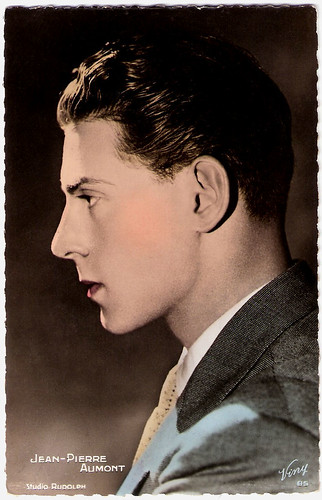
French postcard by Viny, no. 85. Photo: Studio Rudolph.
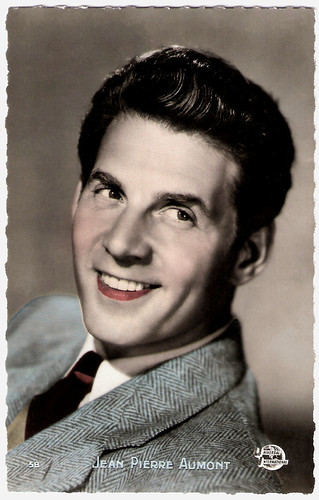
French postcard by Editions P.I., no. 58. Photo: Universal International.
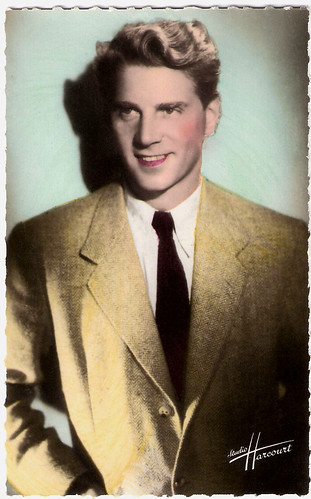
French postcard by Editions O.P., Paris no. 45. Photo: Studio Harcourt.
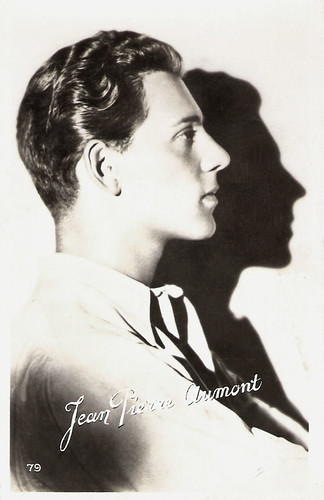
French postcard, no. 79.
Jean-Pierre - or Jean Pierre - Aumont was born as Jean-Pierre Philippe Salomons in Paris in 1909 (some sources say 1911) into a prosperous Jewish family with a passion for the theatre. His parents were Dutch entrepreneur Alexandre Salomons and French actress Suzanne Cahen.
His mother's uncle, stage actor, Georges Berr of the Comédie Francaise, gave Jean-Pierre a glimpse into the theatre world. His younger brother Francois grew up to become director Francois Villiers. Despite many objections from his family, Jean-Pierre went to study drama at the Paris Conservatory at the age of sixteen.
His stage debut occurred in 1930 and his film debut came in Jean de la Lune/Jean of the Moon (Jean Choux, 1931) opposite Michel Simon. His career-defining role was Oedipus in Louis Jouvet's acclaimed 1934 stage production of 'La Machine Infernale' by Jean Cocteau. Cocteau had personally selected the exceptionally good-looking Aumont for the part. 'La Machine Infernale' took on an almost cult-like following among the youth of Paris and was considered a greatly influential breakthrough in French theatre.
From there Aumont’s career both on stage and screen began to take off. James Kirkup writes in his 2001 obituary in The Independent: "At first he played healthy young sporting types with subtle elegance and a light romantic touch that fluttered feminine hearts all over Europe." His first film hit was Lac aux Dames/Ladies Lake (Marc Allégret, 1934) He played an athletic swimming instructor opposite Simone Simon. The role, originally intended for Johnny Weissmuller, "showed off his sporting physique to discreet advantage, and gave him the chance to show a rare gift for comedy", according to Kirkup.
Throughout the 1930s, he was a rising star in French cinema, starring alongside Louis Jouvet in Drôle de Drame/Bizarre, Bizarre (Marcel Carné, 1937) in which he personified a caustic-tongued milkman, and Hôtel du Nord (Marcel Carné, 1938), playing against character as the useless lover of Annabella. Then World War II broke out and his career was cut short.
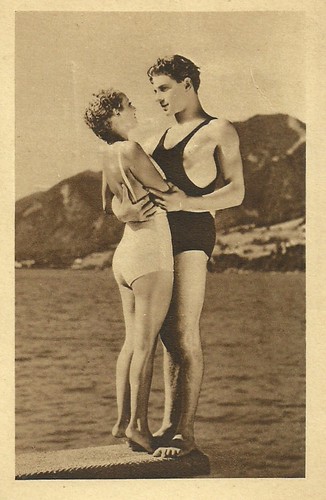
French postcard by Imprimerie A. Breger Frères, Paris. Photo: publicity still for Lac au dames/Ladies Lake (Marc Allégret, 1934). The card was issued for the cinema Max-Linder Pathé, 24, Boulevard Poissonière, Paris, where the film was presented on 14-20 September 1934. Lac au dames/Ladies Lake is situated at Lake Konstanz. In Germany, the film was presented as Hell in Frauensee. 'Frauensee' was the title of the novel by Vicki Baum on which the film was based. The actress Aumont is holding in his arms must be Rosine Dérean.
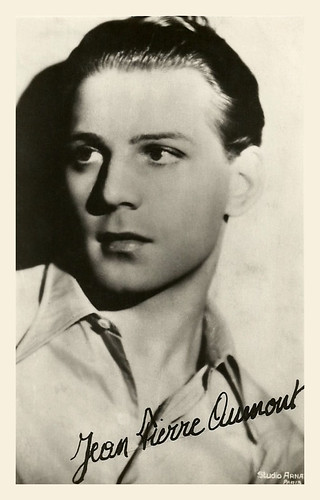
French postcard. Photo: Studio Arna, Paris.
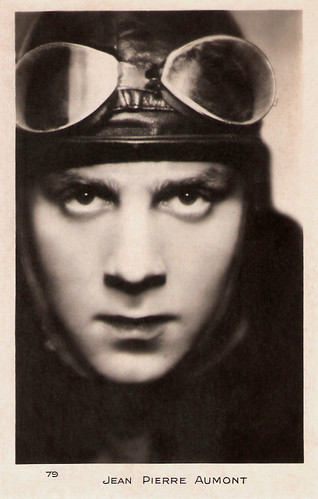
French postcard, no. 79. Jean-Pierre Aumont in L'équipage/Flight Into Darkness (Anatole Litvak, 1935).

French postcard by Erpé, no. 628. Photo: Film Pathé Natan. Jean-Pierre Aumont in L'équipage/Flight Into Darkness (Anatole Litvak, 1935).
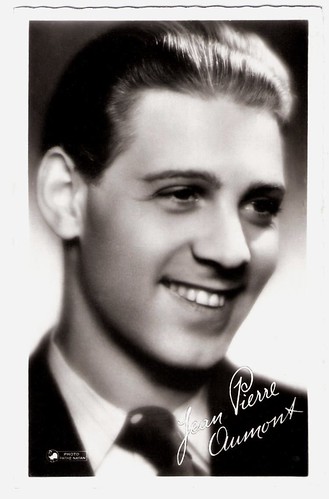
French postcard by Editions et Publications cinématographiques, no. 33. Photo: Pathé Natan.
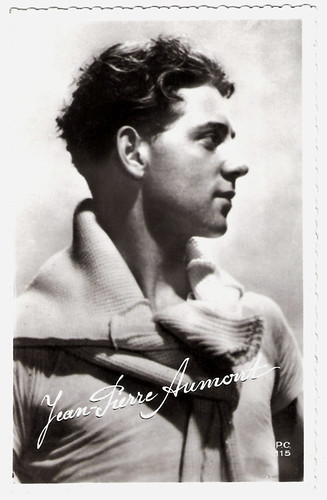
French postcard by P.C., Paris, no. 115.
When the Nazis occupied France in 1940, Jean-Pierre Aumont fled to the US because of his Jewish origins. In Hollywood, he began to work in anti-Nazi propaganda films like The Cross of Lorraine (Tay Garnett, 1943).
At Metro-Goldwyn-Mayer, he enjoyed a successful, if routine, film career. His love life was anything but routine - he almost married Hedy Lamarr and in 1943 he did marry exotic Dominican actress Maria Montez, known as 'the Queen of Technicolor'.
After only one month of marriage, he left the US to join the Free French Forces. He was sent to North Africa and participated in Operation Torch, specifically in Tunisia. He later moved with the Allied armies through Italy and France. He was seriously injured when his Jeep was blown up by a landmined bridge. French Brigadier General Charles-Joseph Brosset, also in the Jeep, was killed.
After the war, Aumont returned to France with Maria Montez. Soon they appeared together in Siren of Atlantis (Gregg Tallas, 1949), a remake of L'Atlantide, with Montez excellent as Queen Antinea. The couple continued to work together in films like Hans le Marin/Hans the Sailor (1949) directed by Aumont's brother, Francois Villiers, and La vendetta del corsaro/Revenge of the Pirates (Primo Zeglio, 1951).
In 1951, Maria suddenly died after fainting and drowning in her bath. After his wife's tragic death, Aumont continued to work both in Hollywood and Europe. He co-starred as the magician in Lili (Charles Walters, 1953) with Leslie Caron, and the film was an enormous success.
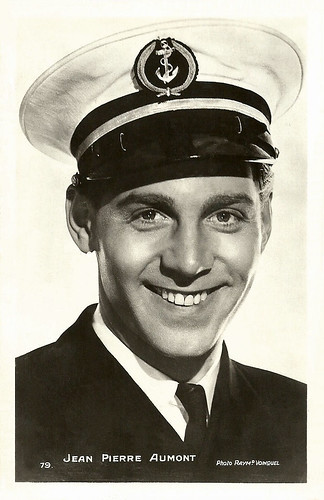
French postcard, no. 79. Photo: Raymond Voinquel.

French postcard by A.N., Paris, no. 981. Photo: S.N.C.
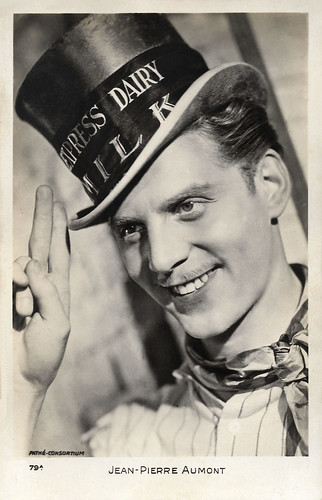
French postcard by Chantal, Paris, no. 79A. Photo: Pathé-Consortium. Publicity still for Drôle de drame/Bizarre, Bizarre (Marcel Carné, 1937).

Spanish postcard by JDP, Valencia, no. 2198. Collection: Marlene Pilaete. With Maria Montez.

With Maria Montez. Dutch postcard, no. 3117. Photo: Universal International.

Dutch postcard, no. A x 447. With Maria Montez.
In 1956 Jean-Pierre Aumont married Italian actress Marisa Pavan, twin sister of Pier Angeli and star of such highly acclaimed films as The Man in the Grey Flannel Suit (Nunnally Johnson, 1956) and The Rose Tattoo (Daniel Mann, 1955). The two starred in one film together, John Paul Jones (John Farrow, 1959) in which Pavan played the romantic lead to Robert Stack and Aumont made a cameo as Louis XVI. They were divorced in 1962, but later they remarried and remained happily married until Aumont's death.
In the 1960s and 1970s, Aumont appeared in the stage production of Gigi and the stage production and the later film adaptation of Des journées entières dans les arbres/Entire Days in the Trees (Marguerite Duras, 1977) as the world-weary, melancholy son of Madeleine Renaud.
With François Truffaut, he worked on La Nuit américaine/Day for Night (1973), a masterwork about the rigours of filmmaking. Aumont played the ageing and somewhat philosophical matinee idol, Alexandre. He also co-starred with Michèle Morgan in Le chat et la souris/Cat and Mouse (Claude Lelouch, 1975).
Later screen work includes Yves Boisset's anti-military Allons z'enfants (1981), the TV mini-series A Tale of Two Cities (Philippe Monnier, 1989) and the Merchant-Ivory films Jefferson in Paris (James Ivory, 1995) and The Proprietor (Ismail Merchant, 1996).
In 1991, Aumont was decorated with the Legion d'Honneur and the Croix de Guerre, because of his bravery during World War II. And in 1992 followed an honorary César Award. In 2001, Jean-Pierre Aumont died of a heart attack at the age of 90. He and Maria Montez had a daughter, Marie-Christine, better known as actress Tina Aumont.
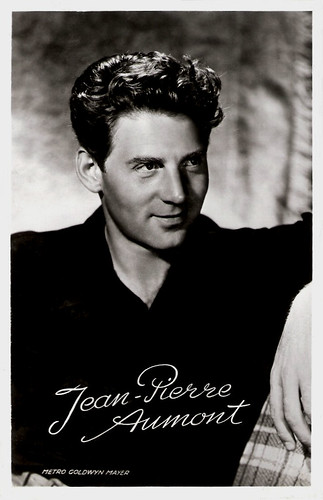
Dutch postcard by Takken, Utrecht, no. 3311. Photo: Metro Goldwyn Mayer.
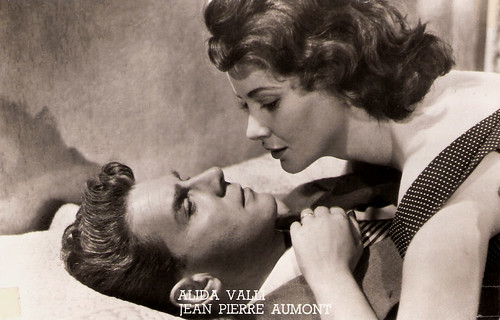
Vintage Postcard, no. 952. Publicity still for Ultimo incontro/Last Meeting (Gianni Franciolini, 1951) with Alida Valli.
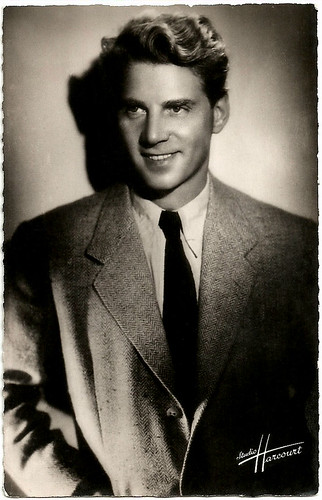
French postcard. Photo: Studio Harcourt.
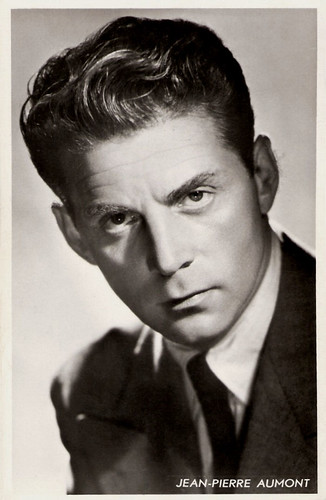
Dutch postcard by Takken, no. 1937.

French postcard by Editions P.I., Paris, no. 521, 1954. Photo: Metro Goldwyn Mayer.
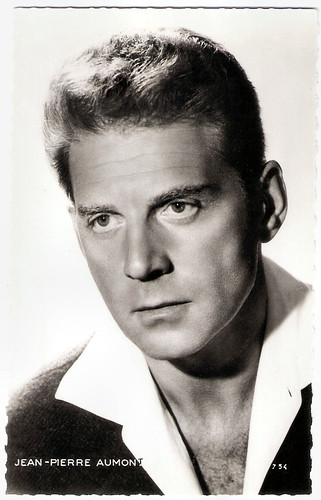
French postcard by Editions P.I., Paris, no. 754. Photo: Sam Lévin.
Sources: Gary Brumburgh (IMDb), James Kirkup (The Independent - now defunct), Wikipedia, and IMDb.
This post was last updated on 5 May 2024.

French postcard by Viny, no. 27. Photo: Star. See also this card.

French postcard by Edition Erpé, Paris, no. 2. Photo: Simson.

French postcard by Viny, no. 85. Photo: Studio Rudolph.

French postcard by Editions P.I., no. 58. Photo: Universal International.

French postcard by Editions O.P., Paris no. 45. Photo: Studio Harcourt.

French postcard, no. 79.
The infernal machine
Jean-Pierre - or Jean Pierre - Aumont was born as Jean-Pierre Philippe Salomons in Paris in 1909 (some sources say 1911) into a prosperous Jewish family with a passion for the theatre. His parents were Dutch entrepreneur Alexandre Salomons and French actress Suzanne Cahen.
His mother's uncle, stage actor, Georges Berr of the Comédie Francaise, gave Jean-Pierre a glimpse into the theatre world. His younger brother Francois grew up to become director Francois Villiers. Despite many objections from his family, Jean-Pierre went to study drama at the Paris Conservatory at the age of sixteen.
His stage debut occurred in 1930 and his film debut came in Jean de la Lune/Jean of the Moon (Jean Choux, 1931) opposite Michel Simon. His career-defining role was Oedipus in Louis Jouvet's acclaimed 1934 stage production of 'La Machine Infernale' by Jean Cocteau. Cocteau had personally selected the exceptionally good-looking Aumont for the part. 'La Machine Infernale' took on an almost cult-like following among the youth of Paris and was considered a greatly influential breakthrough in French theatre.
From there Aumont’s career both on stage and screen began to take off. James Kirkup writes in his 2001 obituary in The Independent: "At first he played healthy young sporting types with subtle elegance and a light romantic touch that fluttered feminine hearts all over Europe." His first film hit was Lac aux Dames/Ladies Lake (Marc Allégret, 1934) He played an athletic swimming instructor opposite Simone Simon. The role, originally intended for Johnny Weissmuller, "showed off his sporting physique to discreet advantage, and gave him the chance to show a rare gift for comedy", according to Kirkup.
Throughout the 1930s, he was a rising star in French cinema, starring alongside Louis Jouvet in Drôle de Drame/Bizarre, Bizarre (Marcel Carné, 1937) in which he personified a caustic-tongued milkman, and Hôtel du Nord (Marcel Carné, 1938), playing against character as the useless lover of Annabella. Then World War II broke out and his career was cut short.

French postcard by Imprimerie A. Breger Frères, Paris. Photo: publicity still for Lac au dames/Ladies Lake (Marc Allégret, 1934). The card was issued for the cinema Max-Linder Pathé, 24, Boulevard Poissonière, Paris, where the film was presented on 14-20 September 1934. Lac au dames/Ladies Lake is situated at Lake Konstanz. In Germany, the film was presented as Hell in Frauensee. 'Frauensee' was the title of the novel by Vicki Baum on which the film was based. The actress Aumont is holding in his arms must be Rosine Dérean.

French postcard. Photo: Studio Arna, Paris.

French postcard, no. 79. Jean-Pierre Aumont in L'équipage/Flight Into Darkness (Anatole Litvak, 1935).

French postcard by Erpé, no. 628. Photo: Film Pathé Natan. Jean-Pierre Aumont in L'équipage/Flight Into Darkness (Anatole Litvak, 1935).

French postcard by Editions et Publications cinématographiques, no. 33. Photo: Pathé Natan.

French postcard by P.C., Paris, no. 115.
Marrying the Queen of Technicolor
When the Nazis occupied France in 1940, Jean-Pierre Aumont fled to the US because of his Jewish origins. In Hollywood, he began to work in anti-Nazi propaganda films like The Cross of Lorraine (Tay Garnett, 1943).
At Metro-Goldwyn-Mayer, he enjoyed a successful, if routine, film career. His love life was anything but routine - he almost married Hedy Lamarr and in 1943 he did marry exotic Dominican actress Maria Montez, known as 'the Queen of Technicolor'.
After only one month of marriage, he left the US to join the Free French Forces. He was sent to North Africa and participated in Operation Torch, specifically in Tunisia. He later moved with the Allied armies through Italy and France. He was seriously injured when his Jeep was blown up by a landmined bridge. French Brigadier General Charles-Joseph Brosset, also in the Jeep, was killed.
After the war, Aumont returned to France with Maria Montez. Soon they appeared together in Siren of Atlantis (Gregg Tallas, 1949), a remake of L'Atlantide, with Montez excellent as Queen Antinea. The couple continued to work together in films like Hans le Marin/Hans the Sailor (1949) directed by Aumont's brother, Francois Villiers, and La vendetta del corsaro/Revenge of the Pirates (Primo Zeglio, 1951).
In 1951, Maria suddenly died after fainting and drowning in her bath. After his wife's tragic death, Aumont continued to work both in Hollywood and Europe. He co-starred as the magician in Lili (Charles Walters, 1953) with Leslie Caron, and the film was an enormous success.

French postcard, no. 79. Photo: Raymond Voinquel.

French postcard by A.N., Paris, no. 981. Photo: S.N.C.

French postcard by Chantal, Paris, no. 79A. Photo: Pathé-Consortium. Publicity still for Drôle de drame/Bizarre, Bizarre (Marcel Carné, 1937).

Spanish postcard by JDP, Valencia, no. 2198. Collection: Marlene Pilaete. With Maria Montez.

With Maria Montez. Dutch postcard, no. 3117. Photo: Universal International.

Dutch postcard, no. A x 447. With Maria Montez.
Ageing and somewhat philosophical matinee idol
In 1956 Jean-Pierre Aumont married Italian actress Marisa Pavan, twin sister of Pier Angeli and star of such highly acclaimed films as The Man in the Grey Flannel Suit (Nunnally Johnson, 1956) and The Rose Tattoo (Daniel Mann, 1955). The two starred in one film together, John Paul Jones (John Farrow, 1959) in which Pavan played the romantic lead to Robert Stack and Aumont made a cameo as Louis XVI. They were divorced in 1962, but later they remarried and remained happily married until Aumont's death.
In the 1960s and 1970s, Aumont appeared in the stage production of Gigi and the stage production and the later film adaptation of Des journées entières dans les arbres/Entire Days in the Trees (Marguerite Duras, 1977) as the world-weary, melancholy son of Madeleine Renaud.
With François Truffaut, he worked on La Nuit américaine/Day for Night (1973), a masterwork about the rigours of filmmaking. Aumont played the ageing and somewhat philosophical matinee idol, Alexandre. He also co-starred with Michèle Morgan in Le chat et la souris/Cat and Mouse (Claude Lelouch, 1975).
Later screen work includes Yves Boisset's anti-military Allons z'enfants (1981), the TV mini-series A Tale of Two Cities (Philippe Monnier, 1989) and the Merchant-Ivory films Jefferson in Paris (James Ivory, 1995) and The Proprietor (Ismail Merchant, 1996).
In 1991, Aumont was decorated with the Legion d'Honneur and the Croix de Guerre, because of his bravery during World War II. And in 1992 followed an honorary César Award. In 2001, Jean-Pierre Aumont died of a heart attack at the age of 90. He and Maria Montez had a daughter, Marie-Christine, better known as actress Tina Aumont.

Dutch postcard by Takken, Utrecht, no. 3311. Photo: Metro Goldwyn Mayer.

Vintage Postcard, no. 952. Publicity still for Ultimo incontro/Last Meeting (Gianni Franciolini, 1951) with Alida Valli.

French postcard. Photo: Studio Harcourt.

Dutch postcard by Takken, no. 1937.

French postcard by Editions P.I., Paris, no. 521, 1954. Photo: Metro Goldwyn Mayer.

French postcard by Editions P.I., Paris, no. 754. Photo: Sam Lévin.
Sources: Gary Brumburgh (IMDb), James Kirkup (The Independent - now defunct), Wikipedia, and IMDb.
This post was last updated on 5 May 2024.
10 comments:
Bob, thanks for introducing me to this movie star. I wasn't acquainted with him. It looks as though he had a busy career. On first glance he reminds me of Kirk Douglas.
I remember him in Lili with Leslie Caron ...
Oh Wow... this handsome movie star certainly had a long 'n interesting life! I too thought he favored Kirk Douglas. This was a fascinating post, and I appreciate the amount of work you put into it. Thanks so much for sharing...
Blessings...
Pearl
April ~Autism Awareness Month~
He's new to me, but so interesting. Not to mention very good-looking. :)
Too often the old stars of yesteryear are forgotten. I thoroughly enjoyed seeing ths wonderful man's photos and reading about his career in film.
Thank you for sharing.
I, on the other hand thought I was looking at a very young Spenser Tracy for just a moment. I recall him in the "...Grey Flannel Suit" but knew nothing about him until today. Another very interesting PFF post.
Very Interesting...I wasn't familiar with him. It is quite handsome!
thank you for introducing me to another European film star! Happy PFF!
Goodness! He has such piercing and intense eyes! You have built such an amazing and valuable resource on this blog Bob!
He was a great actor in France. I always remember him in the classic movie "Hotel du Nord" when he was again a young actor.Thank you and happy PFF
Post a Comment